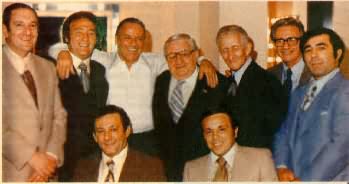
Was Frank Sinatra Exposed in The Godfather?
Frankie and the Boys 1976 - Left to right: Paul Castellano, Gregory DePalma, Sinatra, Tommy Marson, Carlo Gambino, Aladena Fratianno, Salvatore Spatola, Seated: Joseph Gambino, Richard Fusco
The character of Johnny Fontane could be viewed as a symbolic representation of the intergenerational icon known as Frank Sinatra. In the short time that Fontane appeared in the first movie, quite a few extreme parallels between him and Sinatra were made:
|
Johnny Fontane (played by actor/singer Al Martino)
|
Frank Sinatra (Ol' Blue Eyes)
|
| 1) Started career off as a singer in a band. | 1) Started career off in a big band. |
| 2) Got
out of contract with band and became a solo artist (with a little help from
his Godfather, Vito Corleone) |
2) Became solo artist (with help?) |
| 3) Voice became weak | 3) Vocal chords hemorrhaged |
| 4) Career plummeted | 4) Career plummeted |
| 5) Received
(through illegitimate means) a supporting role in a Woltz production that
was guaranteed to "make him a star again." |
5) Earned (?) supporting role in From Here to Eternity that solidified his comeback and won him an Academy Award. |
(facts about the life of Frank Sinatra gathered from U.S. News article and legendsofmusic.com website)
In the book Johnny Fontane's story unfolds further, culminating in him winning an Oscar for his role in the Woltz production, but the film does not include this scene or any other scenes with Fontane after Connie's wedding. From this drastic change from book to film, and the elimination of any further information about Fontane's character, several possible conclusions can be drawn.
Sinatra obviously had friends, or at least acquaintances in the Mafia, as is obvious from the picture above. It is possible that Sinatra, while associated with the Mafia, did not want his public image to be hurt by his criminal ties. And because he had substantial power in Hollywood by the time the film was made (1972), he could have influenced the minimal usage of Fontane's character because of its similarity to Sinatra himself. This way Sinatra can downplay, and almost deny his connections that were so influential for Fontane.
However, it is also possible that the similarities between Sinatra and Fontane are merely bizarre flukes. Perhaps the movie did not want to lose its central focus on the life and times of the Corleone Family in exchange for more information on a pop singer.
While it has never been proven that criminal activity had anything to do with
Sinatra's comeback into in the entertainment industry, one cannot doubt it as
a possibility. For one, Sinatra had many known ties with infamous mobsters across
the globe and the FBI conducted various investigations on him until his death
in 1998. In fact, the FBI had a file of 1275 pages on Sinatra. (Baud).
Needless to say, Fontane and Sinatra have quite a lot in common. Were their
many commonalities just a series of extremely strange coincidences, or was Puzo's
inclusion of Johnny Fontane into The Godfather a planned exposè
of 'the real Sinatra' to a world that has expressed an unconditional love for
him?
Mario Puzo opened the novel The Godfather with a quote from Balzac that read, "Behind every great fortune there is a crime." Those eight words pack quite a punch after thinking about Sinatra's affluence. Did Puzo set out to be a muckraker and thus expose the literate masses (and eventual film-viewing public) to the tremendous power of the crime underworld with the writing of this novel? Puzo never said that The Godfather was in fact a true story, in fact he was committed to his story that he had no help from members of the mafia, and that all the information in the book was purely fictional. (Goldberg) However, the story is remarkably realistic, even according to modern, self-proclaimed mobsters like Sammy "The Bull" Gravano.
For Resource Information Click Here